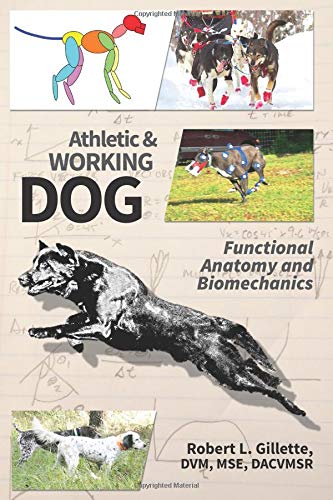Description
Athletic and Working Dog: Functional Anatomy and Biomechanics
I am excited to announce my new publication, Athletic and Working Dog: Functional Anatomy and Biomechanics. The intention of this book is to be a handy guide to the functional anatomy and applied biomechanics of the dog. It was designed to provide the core principles of canine movement to veterinarians, animal physical therapists and those individuals that own, handle or train dogs. It also provides information to those individuals who have an interest in movement of dogs in general.
It begins with an overview of the dog’s neuromusculoskeletal anatomy presented in a functional manner. The second section is designed to present how the science of biomechanics can be easily used to understand movement and performance of the dog. It includes three chapters dedicated to motion analysis and how video analysis can be used to evaluate canine movement.
The information can be used by veterinarians and related health professionals to understand normal and abnormal locomotion when diagnosing lameness in the clinical setting. It can be used by the professional dog trainers and handlers to better understand canine movement and how it applies to dog performance.
The Athletic and Working Dog: Functional Anatomy and Biomechanics addresses the key concepts of musculoskeletal function related to body structure or conformation and movement or locomotion of all dogs as well as the performance of any athletic and working dogs.
The hardcover book can now be purchased at our Web Store. E-books or paperback versions can also be purchased on line at Amazon, Barnes & Noble, Books a Million or many other book stores. Hard cover version are also available at these stores as well. It has over 140 pages and more than 100 figures.
Athletic and Working Dog: Functional Anatomy and Biomechanics
TABLE OF CONTENTS
SECTION 1: FUNCTIONAL ANATOMY
Chapter 01: Introduction
Chapter 02: Skin
Chapter 03: Bones
Chapter 04: Joints and Joint Arthrology
Chapter 05: Muscles, Tendons & Nerves
SECTION 2: BIOMECHANICS AND THE FORCES OF MOVEMENT
Chapter 06: The Fundamental Mechanics of Movement
Chapter 07: Understanding Movement: Canine Biomechanics
Chapter 08: Movement Actions
Chapter 09: Structural Definitions
Chapter 10: Impact Forces
Chapter 11: Locomotion Analysis
Chapter 12: Clinical Gait Analysis
Chapter 13: Video Analysis of Performance


Recent Comments